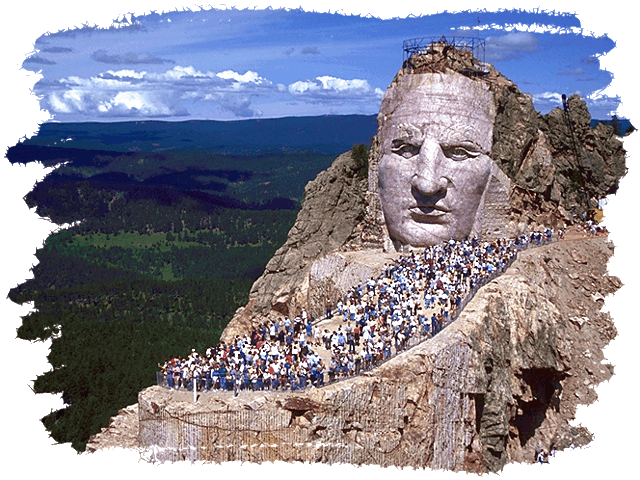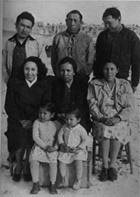
Poetry Presentation, spring 2006
LITR 5731:
Seminar in American Multicultural Literature

Poetry Presentation, spring 2006
9 March 2006
Anuruddha Ellakkala
“Crazy Horse Monument” by Peter Blue Cloud
The author of the poem:
The author of the poem is Peter Blue Cloud; he was born in 1935 “to the Turtle clan of the Mohawk tribe on a reservation in Kahnawake Quebec Canada. He is noted for combining Native American myths with contemporary issues. He has worked as ironworker, logger, carpenter and woodcutter and was previously associated with journal Akwesasne Notes and the journal Indian Magazine. Blue Cloud is especially noted for his use of the Coyote figure in his stories and poems.” He was honored by “American Book Award, Before Columbus Foundation, 1981” (Native American Authors Project) http://www.ipl.org/div/natam/bin/browse.pl/A18
The author’s works:
Peter Blue Cloud published seven books.
(1) Alcatraz is not an island in 1972.
(2) Back then tomorrow (short stories) in 1978.
(3) The other side of nowhere: contemporary coyote tales in 1990.
(4) Elderberry flute song: contemporary coyote tales in 1989.
(5) White corn sister (poetry) in 1979.
(6) Sketches in winter, with crows (poetry) in 1984.
(7) Clans of many nations: selected poems, 1969-1994, publish in 1995.
Crazy Horse:
Crazy Horse is second cousin of Black Elk; and he is the greatest warrior and the leader of the American Indians in their fight with white Americans for the sake of the Indians’ freedom. However, Black Elk says that Crazy Horse was cheated, imprisoned, and later killed by White American. No one knows where he was buried.
Crazy Horse Monument:
The monument is located in the Black Hills near Mount Rushmore. Kristy Pawlak describes that “the white marble statue is the model for the on-going mountain carving which has been under construction since 1948. The artist, Korczak, met Chief Henry Standing Bear in 1940, who was instrumental in the location and initial design of the statue. He wanted the statue built because,”
“‘My fellow chiefs and I
would like the white man to know that the red man has great heroes, too.’”
-- Henry Standing Bear, 1939
Mount Rushmore

Crazy Horse Monument



Crazy Horse Monument and model

“The statue has been built entirely from private donations, admission fees, and other tourism revenue; Korczak established from the outset of the project that he would accept no government funds because he believed in individual initiative and private enterprise.
The statue was designed with Crazy Horse pointing ahead defiantly as a result of his famous answer to a white man’s question, “‘where are your lands now?’” To which he replied, “‘My lands are where my dead lie buried.’” (Quotations from Kristy Pawlak’s poetry presentation, Fall 20004)
A brief definition of the poem:
According to my point of view, the poem has different tones. In first two stanzas of the poem Peter Blue Cloud overwhelm with nature and the natural beauties of their lands. In third, sixth, and the last stanzas, the writer is proud about his departed hero, Crazy Horse. The writer feels security because of “Crazy Horse rides the circle of his people. . .” However, rest of the stanzas the poet is very critical, he wants read Crazy horse’s mind. The writer says, “. . . he (Crazy Horse) would cry in anger of a single death” of his people. Again, the writer asks:
And what would he think of the cold steel chisel,
And of dynamite blasting a mountain’s face,
What value the crumbled glorious of Greece and Rome,
To a people made cold and hungry? (Peter Blue Cloud)
Read the poem. . .
Questions:
(1) How do you define the tones of the poem?
(2) Do you think the poet admires the monument or the natural beauty of their land?
(3) How do you interpret this stanza?
To capture in stone the essence of a man’s spirit,
To portray the love and respect of children and elders,
fashion instead the point of a hunting arrow sharp,
and leave to the elements the wearing-down of time. (Peter Blue Cloud)
(4) Do think White Americans violate Native Americans' freedom of choice by building these monuments in their sacred land?

Ben Black Elk
Black Elk's son,
and father of Olivia and Esther

Olivia and Esther, Black
Elk's two surviving granddaughters, remember this famous holy man well. Considering
that they were in their 20's when he died in 1950, they have shared their
memories about Black Elk in a new book called Black Elk Lives.

A new generation of the Black Elk family. Back row (left to right): Henry, Ben, Nicholas Jr. Middle row (left to right): Olivia, Ellen, Bertha. Front row; Nicholas Jr's daughters Virginia and Theresa.

The Black Elk family, 1945. Back row (left to right), Grace, Olivia, Esther, Katherine. Front row (left to right), Ellen, Ben, Nicholas ("Black Elk"), Benjamin Jr., Henry.
|
|
|
|